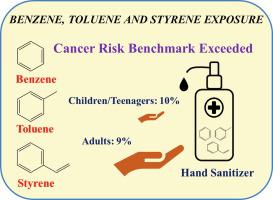Environment International ( IF 10.3 ) Pub Date : 2022-08-04 , DOI: 10.1016/j.envint.2022.107449 Vineet Kumar Pal 1 , Sunmi Lee 1 , Mrudula Naidu 1 , Conner Lee 1 , Kurunthachalam Kannan 1

|
Human exposure to carcinogenic volatile organic compounds (VOCs), such as benzene, from hand sanitizers is a subject of current concern. In light of the heavy use of hand sanitizers during the COVID-19 pandemic, exposure to toxicants present in these products deserves attention. The US Food and Drug Administration (FDA) had set an interim limit for benzene in alcohol-based hand sanitizers at 2000 parts-per-billion (ppb). We determined the concentrations of and exposure to three VOCs, benzene, toluene and styrene, in 200 hand sanitizers using high-resolution gas chromatography coupled with high-resolution mass spectrometry (HRGC-HRMS). Benzene, toluene and styrene were found in 31%, 25% and 32%, respectively, of the samples analyzed at mean concentrations of 395 (range: 0.181–22300), 164 (range: 0.074–20700) and 61.3 ng/g (range: 0.082–4200 ng/g), respectively. Benzene was found at concentrations >2000 ng/g (above the FDA interim limit) in 5% of the samples, representing 9 brands. The mean potential dermal exposure doses (DEDs) to benzene (children/teenagers: 34.6; adults: 24.7 ng/kg-bw/d) were higher than those for toluene (children/teenagers: 14.4; adults: 10.3 ng/kg-bw/d) and styrene (children/teenagers: 5.37; adults: 3.83 ng/kg-bw/d) in the convenience sample of 200 hand sanitizers. The estimated cancer risk from exposure to benzene in children/teenagers and adults from hand sanitizer use (at an estimated usage rate of 5 g/day) was greater than the one-in-a-million risk benchmark (1.0 × 10–6) for 10% and 9% of the samples, respectively. To the best of our knowledge, this is the first study to determine both the concentrations of and exposure risks to benzene, toluene and styrene present in hand sanitizers.
中文翻译:

来自美国的洗手液中苯、甲苯和苯乙烯的发生和皮肤暴露
人类从洗手液中接触致癌的挥发性有机化合物 (VOC),例如苯,是当前关注的主题。鉴于在 COVID-19 大流行期间大量使用洗手液,接触这些产品中存在的有毒物质值得关注。美国食品和药物管理局 (FDA) 已将酒精类洗手液中苯的临时限值设定为 2000 ppb (ppb)。我们使用高分辨率气相色谱结合高分辨率质谱 (HRGC-HRMS) 测定了 200 种洗手液中苯、甲苯和苯乙烯这三种 VOC 的浓度和暴露量。在平均浓度为 395(范围:0.181–22300)、164(范围:0.074–20700)和 61.3 ng/g(范围:0.082–4200 纳克/克),分别。在代表 9 个品牌的 5% 的样品中发现苯的浓度 >2000 ng/g(高于 FDA 临时限值)。苯的平均潜在皮肤暴露剂量 (DEDs)(儿童/青少年:34.6;成人:24.7 ng/kg-bw/d)高于甲苯(儿童/青少年:14.4;成人:10.3 ng/kg-bw /d) 和苯乙烯(儿童/青少年:5.37;成人:3.83 ng/kg-bw/d)在 200 种洗手液的方便样本中。儿童/青少年和成人因使用洗手液(估计使用率为 5 克/天)而接触苯的估计癌症风险高于百万分之一的风险基准(1.0 × 10 苯的平均潜在皮肤暴露剂量 (DEDs)(儿童/青少年:34.6;成人:24.7 ng/kg-bw/d)高于甲苯(儿童/青少年:14.4;成人:10.3 ng/kg-bw /d) 和苯乙烯(儿童/青少年:5.37;成人:3.83 ng/kg-bw/d)在 200 种洗手液的方便样本中。儿童/青少年和成人因使用洗手液(估计使用率为 5 克/天)而接触苯的估计癌症风险高于百万分之一的风险基准(1.0 × 10 苯的平均潜在皮肤暴露剂量 (DEDs)(儿童/青少年:34.6;成人:24.7 ng/kg-bw/d)高于甲苯(儿童/青少年:14.4;成人:10.3 ng/kg-bw /d) 和苯乙烯(儿童/青少年:5.37;成人:3.83 ng/kg-bw/d)在 200 种洗手液的方便样本中。儿童/青少年和成人因使用洗手液(估计使用率为 5 克/天)而接触苯的估计癌症风险高于百万分之一的风险基准(1.0 × 10–6 ) 分别为 10% 和 9% 的样本。据我们所知,这是第一项确定洗手液中苯、甲苯和苯乙烯的浓度和暴露风险的研究。











































 京公网安备 11010802027423号
京公网安备 11010802027423号